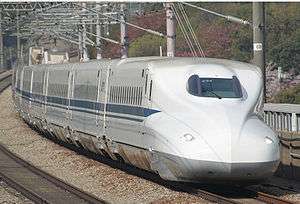E3 Series Shinkansen
The E3 series (E3系) is a Japanese Shinkansen high-speed train type built for Komachi services which commenced on 3 June 1997, coinciding with the opening of the new Akita Shinkansen "mini-shinkansen" line, a regular 1,067 mm (3 ft 6 in) narrow-gauge line between Morioka and Akita re-gauged to 1,435 mm (4 ft 8 1⁄2 in) standard gauge. Later versions of the E3 series were also introduced for use on Yamagata Shinkansen Tsubasa services. Both "mini-shinkansen" lines join the Tohoku Shinkansen, providing services to and from Tokyo.
| E3 series | |
|---|---|
An E3 series set on an Akita Shinkansen Komachi service in March 2008 | |
| In service | 1997–present |
| Manufacturer | Kawasaki Heavy Industries, Tokyu Car Corporation |
| Family name | Mini-shinkansen |
| Replaced | 400 series |
| Constructed | 1995–2009 |
| Scrapped | 2013– |
| Number built | 261 vehicles (41 sets) |
| Number in service | 129 vehicles (19 sets) (as of 1 October 2016) |
| Number scrapped | 132 vehicles |
| Successor | E6 series, E8 series |
| Formation | 6 or 7 cars per trainset |
| Fleet numbers | R1–R26, L51–L55, L61–L72 |
| Capacity | 6-car R sets: 338 (23 Green + 315 Standard) 7-car L50 sets (E3-1000): 402 (23 Green + 379 Standard) 7-car L60 sets (E3-2000): 394 (23 Green + 371 Standard) |
| Operator(s) | JR East |
| Depot(s) | Akita, Yamagata |
| Line(s) served | Tohoku Shinkansen, Yamagata Shinkansen, Joetsu Shinkansen |
| Specifications | |
| Car body construction | Aluminium |
| Car length | 20,050 to 23,070 mm (65 ft 9 in to 75 ft 8 in) |
| Width | 2,945 mm (9 ft 8 in) |
| Doors | 1 per side |
| Maximum speed | 275 km/h (171 mph) (Tohoku Shinkansen), 130 km/h (81 mph) (Akita/Yamagata Shinkansen) |
| Traction system | GTO or IGBT-VVVF (6-car sets: 16 x 300 kW, 7-car sets: 20 x 300 kW) |
| Power output | 6-car sets: 4.8 MW (6,440 hp), 7-car sets: 6 MW (8,050 hp) |
| Acceleration | 1.6 km/h/s |
| Electric system(s) | 20/25 kV AC, 50 Hz overhead catenary |
| Current collection method | Pantograph |
| Safety system(s) | ATC-2, DS-ATC, ATS-P |
| Multiple working | 200 series, E2 series, E4 series, E5 series |
| Track gauge | 1,435 mm (4 ft 8 1⁄2 in) standard gauge |
Design
The design of the original Akita Shinkansen E3 series trains was overseen by industrial designer Kenji Ekuan.[1] Like the 400 Series Shinkansen, these trains are built to a smaller loading gauge than mainline Shinkansen trains—the width and length of each car is reduced to fit on the narrower clearances of the "mini-shinkansen". Doorway steps fold out to bridge the gap between the narrow body and the platform at regular shinkansen stations.
- An extended doorway step on an E3 series Komachi set
Variants
- E3 series "R" sets: 26 x 6-car sets used on Akita Shinkansen Komachi services since 3 June 1997
- E3-1000 series "LR" sets: 3 x 7-car sets used on Yamagata Shinkansen Tsubasa services since 4 December 1999
- E3-2000 series "LR" sets: 12 x 7-car sets used on Yamagata Shinkansen Tsubasa services since 20 December 2008
- E3-700 series Toreiyu: 6-car excursion trainset used on Yamagata Shinkansen from July 2014
- E3-700 series Genbi Shinkansen: 6-car excursion trainset used on Joetsu Shinkansen from 29 April 2016 to December 2020.[2]
Pre-series set
A pre-series 5-car set, numbered S8, was delivered from Kawasaki Heavy Industries to Sendai Depot in March 1995 for extensive testing. It was modified to full-production specifications in March 1997 ahead of the start of Akita Shinkansen services.[3]
Until it was augmented to six cars in 1998, the pre-series was formed as follows, with scissors-type pantographs on cars 12, 13, and 14.[3] Set R1 was withdrawn following its final revenue run on 20 July 2013.[4]
| Car No. | 11 | 12 | 13 | 14 | 15 |
|---|---|---|---|---|---|
| Designation | M1sc | M2 | T | M1 | M2c |
| Numbering | E311-1 | E326-1 | E329-1 | E325-1 | E322-1 |
 Pre-series set R1 in service, March 2013
Pre-series set R1 in service, March 2013
E3 series "R" sets

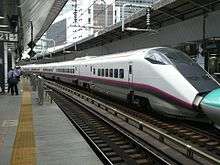
The full-production trainsets built from 1996 for the Akita Shinkansen were 5-car sets, but sixth cars were added by the end of 1998. A total of 26 Akita Shinkansen sets were in service by the end of 2005. Sets R1 to R16 were leased by East Japan Railway Company (JR East) from the owning company, Akita Shinkansen Sharyō Hoyū (秋田新幹線車両保有(株)), a third-sector company jointly owned by JR East and Akita Prefecture.[5] This lease ended on 21 March 2010 with the dissolution of Akita Shinkansen Sharyō Hoyū.[6]
The E3 series sets are scheduled to be phased out following the introduction of new E6 series sets from March 2013, with 19 sets (114 vehicles) scheduled to be withdrawn during fiscal 2013.[7]
From the start of the 15 March 2014 timetable revision, E3 series trainsets were no longer used on Akita Shinkansen Komachi services.[8] Two sets remained in service, used on Yamabiko and Nasuno services.[8]
Formation
| Car No. | 11 | 12 | 13 | 14 | 15 | 16 |
|---|---|---|---|---|---|---|
| Designation | M1sc | M2 | T1 | T2 | M1 | M2c |
| Numbering | E311 | E326 | E329 | E328 | E325 | E322 |
| Seating capacity | 23 | 67 | 60 | 68 | 64 | 56 |
Cars 12 and 15 are equipped with PS206 single-arm pantographs.[5]
Fleet history
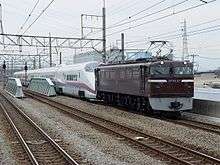
The build details are as shown below.[9] As of 1 October 2016, two (sets R21 and R22) of the original 26 sets are in operation.[10]
| Set No. | Date delivered | Car 14 build date | Date withdrawn | Remarks |
|---|---|---|---|---|
| R1 | 28 March 1995 | 29 October 1998 | 26 August 2013 | Pre-series set S8 (originally 5 cars with 3 pantographs) |
| R2 | 9 October 1996 | 1 November 1998 | 13 December 2013[11] | Built as 5-car sets |
| R3 | 14 October 1996 | 4 November 1998 | 17 February 2014[11] | |
| R4 | 22 October 1996 | 6 November 1998 | 9 January 2014[11] | |
| R5 | 28 October 1996 | 9 November 1998 | 26 April 2013 | |
| R6 | 6 November 1996 | 12 November 1998 | 12 April 2013 | |
| R7 | 11 November 1996 | 22 November 1998 | 17 May 2013 | |
| R8 | 15 November 1996 | 24 November 1998 | 24 May 2013 | |
| R9 | 22 November 1996 | 26 November 1998 | 7 June 2013 | |
| R10 | 2 December 1996 | 28 November 1998 | 27 August 2013 | |
| R11 | 12 December 1996 | 30 October 1998 | 13 September 2013 | |
| R12 | 21 December 1996 | 17 November 1998 | 27 November 2013[11] | |
| R13 | 20 January 1997 | 5 December 1998 | 19 October 2013[11] | |
| R14 | 30 January 1997 | 14 November 1998 | 1 December 2013[11] | |
| R15 | 7 February 1997 | 16 November 1998 | 28 January 2014[11] | |
| R16 | 17 February 1997 | 19 November 1998 | 8 March 2014[11] | |
| R17 | 30 September 1998 | n/a (6-car sets from new) |
26 July 2013 | |
| R18 | 23 October 2002 | Converted 2014 to E3-700 series Toreiyu[12] | ||
| R19 | 18 November 2002 | Converted 2016 to E3-700 series Genbi Shinkansen[13] | ||
| R20 | 24 March 2003 | 17 December 2015[14] | ||
| R21 | 16 September 2003 | |||
| R22 | 27 October 2003 | |||
| R23 | 1 December 2003 | - | Converted 2014 to become Set L55 | |
| R24 | 4 April 2005 | 4 December 2013[Note 1] | Converted 2014 to become Set L54 | |
| R25 | 11 July 2005 | 18 December 2013[Note 2] | Converted 2014 to become Set L54 | |
| R26 | 25 July 2005 | - | Converted 2014 to become Set L55 |
Interior
- Green car interior
 Interior of standard-class car 12
Interior of standard-class car 12- Interior of standard-class car 16
E3-1000 series
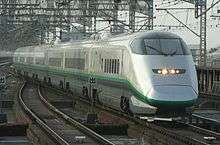
Three 7-car E3-1000 sets (numbered L51 – L53) were built between 1999 and 2005 for use on Yamagata Shinkansen Tsubasa services from 4 December 1999 to augment the 400 series fleet following with the extension of the line to Shinjo.[15] From 2014, a further two sets (L54 and L55) were introduced, reformed from withdrawn Akita Shinkansen E3-0 series "R" sets, to replace the two older sets L51 and L52.[16]
Formation
The sets are formed as shown below, with five motored ("M") cars and two non-powered trailer ("T") cars, and car 11 at the Tokyo end.
| Car No. | 11 | 12 | 13 | 14 | 15 | 16 | 17 |
|---|---|---|---|---|---|---|---|
| Designation | M1sc | M2 | T1 | M2 | T2 | M1 | M2c |
| Numbering | E311-1000 | E326-1000 | E329-1000 | E326-1100 | E328-1000 | E325-1000 | E322-1000 |
| Seating capacity | 23 | 67 | 60 | 68 | 64 | 64 | 56 |
Cars 12 and 14 are equipped with PS206 single-arm pantographs.[5]
Interior
 Standard class car interior
Standard class car interior
Fleet history
The build details are as shown below.[11]
| Set No. | Manufacturer | Date delivered | Date reliveried | Date withdrawn | Remarks |
|---|---|---|---|---|---|
| L51 | Tokyu Car | 11 August 1999 | - | 5 September 2014[17] | |
| L52 | Kawasaki Heavy Industries | 11 September 1999 | - | 4 February 2015[18] | |
| L53 | Tokyu Car | 17 August 2005 | 24 November 2015[10] | ||
| L54 | Kawasaki Heavy Industries[18] | 30 July 2014[18] | 30 July 2014[18] | Rebuilt from sets R24+R25 | |
| L55 | J-TREC[18] | 13 January 2015[18] | 13 January 2015[18] | Rebuilt from sets R23+R26 |
L54/L55 conversion details

The former identities of the cars reformed into sets L54 and L55 are as shown below.[16]
| Set No. | Car No. | Running No. | Former set No. | Former car No. | Former running No. |
|---|---|---|---|---|---|
| L54 | 11 | E311-1004 | R25 | 11 | E311-25 |
| 12 | E326-1004 | R25 | 12 | E326-25 | |
| 13 | E329-1004 | R25 | 13 | E329-25 | |
| 14 | E326-1104 | R24 | 12 | E326-24 | |
| 15 | E328-1004 | R24 | 13 | E329-24 | |
| 16 | E325-1004 | R25 | 15 | E325-25 | |
| 17 | E322-1004 | R25 | 16 | E322-25 | |
| L55 | 11 | E311-1005 | R26 | 11 | E311-25 |
| 12 | E326-1005 | R26 | 12 | E326-25 | |
| 13 | E329-1005 | R26 | 13 | E329-26 | |
| 14 | E326-1105 | R23 | 12 | E326-23 | |
| 15 | E328-1005 | R23 | 13 | E329-23 | |
| 16 | E325-1005 | R26 | 15 | E325-26 | |
| 17 | E322-1005 | R26 | 16 | E322-26 |
E3-2000 series

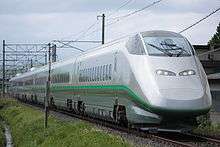
The first of a fleet of twelve new E3-2000 series 7-car sets entered service on Yamagata Shinkansen Tsubasa services on 20 December 2008.[19] The new fleet totally replaced the older 400 series trains by summer 2009. The new trains incorporate design improvements, including active suspension, full-colour LED destination indicators, and AC power outlets in all cars.[20] Seating capacity in cars 16 and 17 has been reduced by 4 (one row of seats) compared with the E3-1000 series to provide uniform seating pitch in all cars (seat pitch was previously reduced in non-reserved cars).
Formation
| Car No. | 11 | 12 | 13 | 14 | 15 | 16 | 17 |
|---|---|---|---|---|---|---|---|
| Designation | M1sc | M2 | T1 | M2 | T2 | M1 | M2c |
| Numbering | E311-2000 | E326-2000 | E329-2000 | E326-2100 | E328-2000 | E325-2000 | E322-2000 |
| Seating capacity | 23 | 67 | 60 | 68 | 64 | 60 | 52 |
Cars 12 and 14 are equipped with PS206 single-arm pantographs.[5]
 E311-2009 (car 11)
E311-2009 (car 11) E326-2009 (car 12)
E326-2009 (car 12) E329-2009 (car 13)
E329-2009 (car 13) E326-2109 (car 14)
E326-2109 (car 14) E328-2009 (car 15)
E328-2009 (car 15) E325-2009 (car 16)
E325-2009 (car 16) E322-2009 (car 17)
E322-2009 (car 17)
Fleet history
As of 1 October 2016, the E3-2000 series fleet is as follows.[10]
| Set No. | Manufacturer | Date delivered | Date reliveried |
|---|---|---|---|
| L61 | Kawasaki HI | 9 October 2008 | 6 July 2016 |
| L62 | Kawasaki HI | 9 December 2008 | |
| L63 | Kawasaki HI | 7 January 2009 | 24 November 2015 |
| L64 | Kawasaki HI | 17 February 2009 | 25 April 2014 |
| L65 | Kawasaki HI | 3 March 2009 | 6 June 2014 |
| L66 | Kawasaki HI | 25 March 2009 | 22 October 2014 |
| L67 | Tokyu Car | 28 March 2009 | 12 November 2014 |
| L68 | Kawasaki HI | 14 April 2009 | 5 December 2014 |
| L69 | Kawasaki HI | 19 May 2009 | 23 February 2015 |
| L70 | Kawasaki HI | 30 June 2009 | 6 April 2016 |
| L71 | Kawasaki HI | 22 July 2009 | 24 April 2016 |
| L72 | Kawasaki HI | 25 March 2010 | 18 September 2015 |
Interior
 Standard class car interior
Standard class car interior
Reliverying
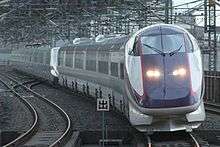
From spring 2014, the entire fleet of 15 E3-1000 and E3-2000 series Tsubasa sets is scheduled to be reliveried in a new colour scheme designed by industrial designer Ken Okuyama.[21] The new colour scheme uses white, evoking the snow of Mount Zaō, deep purple inspired by the Mandarin duck, the prefectural bird for Yamagata Prefecture, together with yellow and red for the safflower, the prefectural flower of Yamagata Prefecture.[22] The first reliveried set is scheduled to appear in late April.[22] Three sets were repainted by June 2014, and the rest of the fleet of 15 sets was repainted by mid 2016.[21]
 Apple and rice motif
Apple and rice motif Cherry and safflower motif
Cherry and safflower motif
E3-700 series Toreiyu excursion set

This is a six-car set rebuilt from former Akita Shinkansen trainset R18[12] as an excursion train named Toreiyu (とれいゆ) for use on the Yamagata Shinkansen between Fukushima and Shinjo, entering service from July 2014.[23] The design work for the rebuilt train was overseen by industrial designer Ken Okuyama.[24] The six-car set has a total seating capacity of 143 passengers.[23] Car 11 is a standard-class car with reserved seating arranged 2+2 abreast, cars 12 to 14 feature Japanese-style tatami seating, car 15 is a lounge car with a bar counter, and car 16 has ashiyu foot baths.[23] The name of the train is a portmanteau of the English word "train" and the French word "soleil" (sun).[23] The train is normally used on special Toreiyu Tsubasa services running at weekends.[23]
Formation
The Toreiyu set is based at Yamagata Depot and formed as shown below, with car 11 at the Fukushima end.[12]
| Car No. | 11 | 12 | 13 | 14 | 15 | 16 |
|---|---|---|---|---|---|---|
| Designation | M1c | M2 | T1 | T2 | M1 | M2c |
| Numbering | E321-701 | E326-701 | E329-701 | E328-701 | E325-701 | E322-701 |
| Facilities | 2+2 seating | Japanese-style seating | Japanese-style seating | Japanese-style seating | Lounge + bar counter | Ashiyu foot baths |
- Interior of car 11 with conventional seating
- Interior of car 14 with Japanese-style tatami seating
- The tatami lounge area in car 15
- The bar counter in car 15
- The entrance to car 16
- The ashiyu foot baths at the end of car 16
E3-700 series Genbi Shinkansen excursion set

This is a six-car set rebuilt from former Akita Shinkansen trainset R19 at Kawasaki Heavy Industries in Kobe as an excursion train named Genbi Shinkansen (現美新幹線, "contemporary art shinkansen") for use on the Joetsu Shinkansen between Echigo-Yuzawa and Niigata, mostly at weekends, entering service from 29 April 2016.[25] The exterior livery was designed by photographer Mika Ninagawa.[13] The first car of the six car set features the art of Nao Matsumoto; a golden yellow motif based on harvests, festivals and light is present in the car. Window shades display art using a special dye as the train passes through tunnels. The second car feature stainless steel mirrors on the walls, the work of Yusuke Komuta. They reflect the landscape outside the train. The third car features a children's area and a cafe. The children's area features blue and white representations of toy trains by Art Unit Paramodel. The cafe section of the car is designed by Kentaro Kobuke and serves sweet items featuring local products. The fourth car features an alpine photography exhibition by Naoki Ishikawa. The fifth car features an abstract flower artpiece by Haruka Koujin that vibrates with the motion of the train. The final car features a short film by Brian Alfred, depicting the scenery of Niigata.[26] The trainset was shown off to the media on 12 January 2016.[13]
Formation
The Genbi Shinkansen set is based at Niigata Depot and formed as shown below, with car 11 at the Tokyo end.[25]
| Car No. | 11 | 12 | 13 | 14 | 15 | 16 |
|---|---|---|---|---|---|---|
| Designation | M1c | M2 | T1 | T2 | M1 | M2c |
| Numbering | E321-702 | E326-702 | E329-702 | E328-702 | E325-702 | E322-702 |
| Former number | E311-19 | E326-19 | E329-19 | E328-19 | E325-19 | E322-19 |
| Facilities | 2+2 seating | Art gallery space | Cafe + children's play area | Art gallery space | Art gallery space | Art gallery space |
Cars 12 and 15 each have one single-arm pantograph.[25]
 The interior of reserved-seating car 11 in January 2018
The interior of reserved-seating car 11 in January 2018 The interior of car 12 in January 2018 (mirror installation by Yusuke Komuta)
The interior of car 12 in January 2018 (mirror installation by Yusuke Komuta) The cafeteria counter in Car 13 in June 2017
The cafeteria counter in Car 13 in June 2017 The children's play area in car 13 in June 2017
The children's play area in car 13 in June 2017 The interior of car 14 in January 2018 (photographs by Naoki Ishikawa)
The interior of car 14 in January 2018 (photographs by Naoki Ishikawa)
See also
References
- "The Works of GK Design Group". GK Design Group Inc. Archived from the original on 17 February 2015. Retrieved 10 February 2015.
- https://tetsudo-shimbun.com/headline/entry-2823.html
- 新幹線電車データブック2011 [Shinkansen Databook 2011]. Japan: Kotsu Shimbunsha. March 2011. ISBN 978-4-330-19811-8.
- JR東日本E3系R1編成引退 [JR East E3 series set R1 retired]. The Railway Pictorial (in Japanese). Japan: Denkisha Kenkyūkai. 63 (880): 92. October 2013.
- JR電車編成表 2009夏 [JR EMU Formations - Summer 2009]. Japan: Kotsu Shimbunsha. June 2009. ISBN 978-4-330-06909-8.
- 県に出資金115億円返還へ 秋田新幹線車両保有会社. Akita Sakigake Shimpo (in Japanese). Japan. 22 January 2010. Archived from the original on 17 July 2011. Retrieved 4 February 2010.
- 2013年度総合車両センター関係業務改善が提案される [Work Improvements Proposed for General Rolling Stock Center in Fiscal 2013] (PDF). Danketsu (in Japanese). Japan: National Railway Workers' Union. 27 January 2013. Retrieved 11 February 2013.
- 3月15日ダイヤ改正と各地の話題 [15 March timetable revision and topics from around the regions]. Tetsudō Daiya Jōhō Magazine (in Japanese). Vol. 43 no. 361. Japan: Kōtsū Shimbun. May 2014. p. 13.
- JR電車編成表 2013夏 [JR EMU Formations - Summer 2013]. Japan: Kotsu Shimbunsha. May 2013. p. 20. ISBN 978-4-330-37313-3.
- JR電車編成表 2017冬 [JR EMU Formations - Winter 2017] (in Japanese). Japan: Kotsu Shimbunsha. 16 November 2016. p. 118. ISBN 978-4-330-73716-4.
- JR電車編成表 2014夏 [JR EMU Formations - Summer 2014]. Japan: Kotsu Shimbunsha. 30 May 2014. pp. 20–24, 356. ISBN 978-4-330-46614-9.
- Shiraishi, Hiroyuki (August 2014). 平成26年3月15日ダイヤ改正にともなうJR東日本車両の動き [JR East fleet changes following 15 March 2014 timetable revision]. Japan Railfan Magazine (in Japanese). Vol. 54 no. 640. Japan: Koyusha Co., Ltd. p. 73.
- E3系改造"GENBI SHINKANSEN"を報道公開 [Rebuilt E3 series "Genbi Shinkansen" shown off to the press]. Tetsudō Daiya Jōhō Magazine (in Japanese). Vol. 45 no. 383. Japan: Kōtsū Shimbun. March 2016. p. 4.
- JR車両のうごき [JR rolling stock changes]. Tetsudō Daiya Jōhō Magazine (in Japanese). Vol. 45 no. 383. Japan: Kōtsū Shimbun. March 2016. p. 127.
- JR電車編成表 2013冬 [JR EMU Formations - Winter 2013]. Japan: Kotsu Shimbunsha. November 2012. p. 24. ISBN 978-4-330-33112-6.
- E3系 山形新幹線転用車両 [E3 series trains reallocated to Yamagata Shinkansen]. Japan Railfan Magazine (in Japanese). Vol. 54 no. 642. Japan: Koyusha Co., Ltd. October 2014. pp. 86–87.
- JR電車編成表 2015冬 [JR EMU Formations - Winter 2015] (in Japanese). Japan: Kotsu Shimbunsha. 21 November 2014. pp. 26, 357. ISBN 978-4-330-51614-1.
- JR電車編成表 2015夏 [JR EMU Formations - Summer 2015] (in Japanese). Japan: Kotsu Shimbunsha. 20 May 2015. pp. 23, 26, 358. ISBN 978-4-330-56915-4.
- "山形新幹線に新型車両" (New Trains for Yamagata Shinkansen). (20 December 2008) Archived 13 July 2012 at Archive.today. Retrieved on 20 December 2008. (in Japanese)
- 山形新幹線「つばさ」用車両の新造について (PDF) (Press release) (in Japanese). JR East. 3 July 2007. Retrieved 10 August 2008.
- 山形新幹線 「つばさ」塗装リニューアル [Yamagata Shinkansen Tsubasa trains to be repainted]. Kahoku Online Network (in Japanese). Japan: Kahoku Shimpo Publishing. 29 August 2013. Archived from the original on 1 September 2013. Retrieved 30 August 2013.
- "山形新幹線E3系のエクステリアデザインを変更" [Exterior design change for Yamagata Shinkansen E3 series]. Japan Railfan Magazine Online (in Japanese). Japan: Koyusha Co., Ltd. 4 March 2014. Retrieved 4 March 2014.
- "山形エリアにE3系改造車「とれいゆ」を導入" [Rebuilt E3 series Toreiyu to be introduced in Yamagata area]. Japan Railfan Magazine Online (in Japanese). Japan: Koyusha Co., Ltd. 4 March 2014. Retrieved 4 March 2014.
- 山形新幹線に新たな魅力が誕生します! [A new allure born on the Yamagata Shinkansen] (PDF). News release (in Japanese). Japan: East Japan Railway Company. 4 March 2014. Retrieved 4 March 2014.
- E3系「GENBI SHINKANSEN」 [E3 series Genbi Shinkansen]. Japan Railfan Magazine (in Japanese). Vol. 56 no. 661. Japan: Koyusha Co., Ltd. May 2016. pp. 72–73.
- Japan Railway Journal. Prepaid E-money Cards: The Smart Way to Travel in Japan. NHK World. 3 August 2017. Event occurs at 22:40. Archived from the original on 5 August 2017. Retrieved 4 August 2017.
External links
| Wikimedia Commons has media related to E3 series. |
- E3 Series Tsubasa/Yamabiko/Nasuno (in Japanese)
